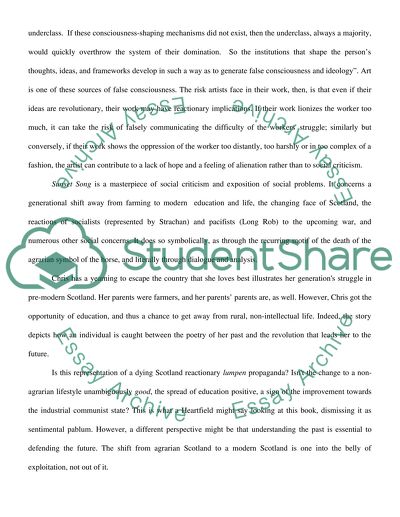Cite this document
(The Cost of Art During Revolution Essay Example | Topics and Well Written Essays - 2000 words, n.d.)
The Cost of Art During Revolution Essay Example | Topics and Well Written Essays - 2000 words. Retrieved from https://studentshare.org/literature/1574091-you-cannot-be-a-loyal-servant-of-both-poetry-and-the-revolution-brown-and-gupta-2005-p177-discuss-this-statement-in-relation-to-two-passages-from-lewis-grassic-gibbons-sunset-song-and-two-poems-in-skeltons-poetry-of-the-thirt
The Cost of Art During Revolution Essay Example | Topics and Well Written Essays - 2000 words. Retrieved from https://studentshare.org/literature/1574091-you-cannot-be-a-loyal-servant-of-both-poetry-and-the-revolution-brown-and-gupta-2005-p177-discuss-this-statement-in-relation-to-two-passages-from-lewis-grassic-gibbons-sunset-song-and-two-poems-in-skeltons-poetry-of-the-thirt
(The Cost of Art During Revolution Essay Example | Topics and Well Written Essays - 2000 Words)
The Cost of Art During Revolution Essay Example | Topics and Well Written Essays - 2000 Words. https://studentshare.org/literature/1574091-you-cannot-be-a-loyal-servant-of-both-poetry-and-the-revolution-brown-and-gupta-2005-p177-discuss-this-statement-in-relation-to-two-passages-from-lewis-grassic-gibbons-sunset-song-and-two-poems-in-skeltons-poetry-of-the-thirt.
The Cost of Art During Revolution Essay Example | Topics and Well Written Essays - 2000 Words. https://studentshare.org/literature/1574091-you-cannot-be-a-loyal-servant-of-both-poetry-and-the-revolution-brown-and-gupta-2005-p177-discuss-this-statement-in-relation-to-two-passages-from-lewis-grassic-gibbons-sunset-song-and-two-poems-in-skeltons-poetry-of-the-thirt.
“The Cost of Art During Revolution Essay Example | Topics and Well Written Essays - 2000 Words”, n.d. https://studentshare.org/literature/1574091-you-cannot-be-a-loyal-servant-of-both-poetry-and-the-revolution-brown-and-gupta-2005-p177-discuss-this-statement-in-relation-to-two-passages-from-lewis-grassic-gibbons-sunset-song-and-two-poems-in-skeltons-poetry-of-the-thirt.


